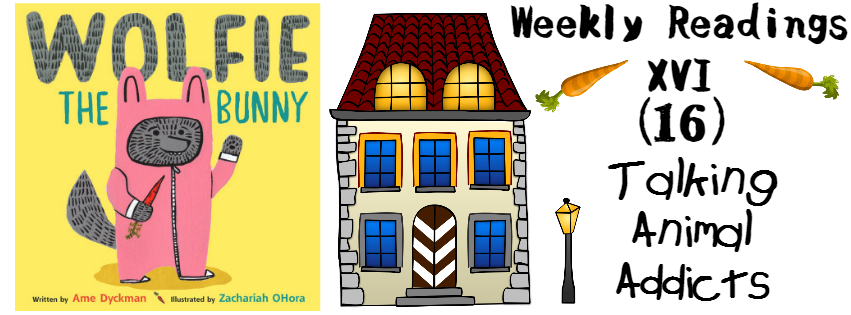I’ve long wanted to do reviews of comics/graphic novels on T.A.A. for some time, but it didn’t fit in the “Weekly Readings” format I use for picture book reviews.
Why? Because while picture books are just as visual as comics and graphic novels, the latter requires A LOT MORE of its readers.
They’re also a lot longer than picture books, and can tell more complex plots and often include at least one subplot.
The blend of words and pictures is more sophisticated than it might first look.
The stories in the panels, and occasional full page spreads, can be as complex or as simple as their creator(s) desire, FAR more freedom than the average picture book.
Those who say comics aren’t “REAL READING” are WAY mistaken!
At T.A.A. we want to champion the fun, the fantastical, and fauna, that gives those without a voice in “reality” a voice on T.A.A. and beyond!
Your lit. rat came to comics FAR LATER in his life, and my tastes are highly eclectic, but because I have a limited pool of knowledge…
I’ve enlisted my friends/podcasting partners
(and self-proclaimed comics connoisseurs), Swinebert & Dempsey (@Swinebert_and_D), to take part in our comics/graphic novel reviews on T.A.A.
For our first edition of “Panel by Panel”, Swinebert, Dempsey and I are reviewing our mutual Twitter buddy, Eric Orchard’s debut graphic novel-
-
Maddy Kettle
(Book 1): The Adventure of the Thimblewitch
by Eric Orchard (@inkybat)
Publisher: Top Shelf Productions
Pub. Date: September 30th, 2014
Swinebert: Yo Chicks and Chickies! Welcome to the first edition of “Panel by Panel” where my pal Dempsey and I chat about out one of our many passions-COMICS! (and graphic novels)
Dempsey: When our friend (and podcast director/producer), Taurean J. Watkins (aka “The Literary Rat), approached us to be on his reviews team, we knew we wanted to do comics, and it was unanimous what our first book would be…
From “The Literary Rat”, Taurean J. Watkins (@Taurean_Watkins)
Something that I think has held some comics and graphic novels back is feeling they have to been in one camp versus another.
You either have to be “Funny” or “Dark and Brooding” but they can’t be both or a middle ground between the two.
Every reader wants something a bit different, and for me, generally speaking, I gravitate to books that can make me laugh, but they’re also not afraid to get serious when the story demands and deserves it.
Even when you’re writing about steampunk flying machines, witches and pipe-smoking critters, there is still a level of seriousness that the reader can take seriously in the context of the story’s world, the less it’s like ours, the more crucial that is.
(Naruto Vol. 5/Naruto Vol. 28,
One Piece Vol. 11/One Piece Vol. 61)
Series like “Naruto” and “One Piece” are great examples of this.
Like the series above, this book has a very distinct art style, the mural-like compostion is apparent from the cover onward, the panels are clearly defined without looking sterile.
I love the use of shadow and light at play, and the soft rounded/angular look to the characters.
Even the clouds have their own distictive look, slightly reminiscent of those old school cloud trails via 1930s cartoons with a slight nod to the psychedelic 60s in terms of color shading. This mix of bright colors and mural-style presentation made the book feel modern yet retro in the good sense of the latter.
My road to reviewing “Maddy Kettle” is an intersting one.
Often writers debate amongst themselves if social media is worth their time, and if so, what platforms make sense for them.
I know many of my favorite authors simply aren’t interested in social media or simply find it too much of a time suck that would prevent them from writing actual books, they don’t even have a basic website (which I think even the most luddite folks need, but I’m not getting on that soapbox here! LOL).
But for me, I would likely never have learned about “Maddy Kettle” had I not been on Twitter and started connecting with artist-author Eric Orchard (@inkybat on Twitter), at least not as soon as I did.
There really is a skill to reading comics and graphic novels. Just as there is great skill in crafting them in the first place.
From developing the story, scripting the dialogue, drawing the art (or hiring the illustrator if the author’s not also the illustrator, the latter a lot more common in the comics/graphic novel space than picture books), and bringing it all together in the final book we buy.
As an author myself, I know firsthand that some of the hardest things to pull off, look the most effortless to lay readers, and from the cover onward, you can feel the care and attention that went into this book.
 Swinebert’s Thoughts
Swinebert’s Thoughts
Back in Fall 2014, when I got my hooves on “Maddy Kettle” I knew from the first few pages this was a book I’d always cherish, and the fact that it’s the first of a multi-volume series only has me jonesing for the next installment.
Side Note: Since Dempsey and I first connected with artist/author Eric Orchard on Twitter, we often wondered where his *handle “Inkybat” came from, and after reading “Maddy Kettle”, we now know…
[*Handle is another way of saying Nickname or Username.]
Anyway, back in late Summer 2014, my nephew Trug saw the cover (while D and I were conversing with the author on Twitter), he said, “Uncle Swinebert, to the bookstore, now!”
The book wasn’t out yet, but our pal and producer, Taurean J. Watkins, found the book on Net Galley, and after checking it out himself, he shared it with me and Dempsey, and I shared it with Trug, and here’s what he says-
“I’ve been in love since seeing the cover (back in August) I finally read it and it ROCKS! I’ll be on ‘Cloud Nine’ to get the next installment.”
-Trug Glockchester
Dempsey’s Thoughts
I LOVE heroes, or in this case HEROINES, like Maddy for many reasons.
First, she LOVES books, as do I, be they fiction, nonfiction, poetry, and (obviously) comics and graphic novels.
Second, she’s not afraid to take charge of a situation, even if those closest to her (such her overprotective yet thoughtful parents, who when this story begins are Kangaroo rats, more on that later…) would rather her take a “wait and see” approach, which in real life is sometimes the best move, but doesn’t nesscarially make for thrilling storytelling.
Third, she drives her own story, BUT, is not above getting help along the way.
While first-time entrepenuers often shout “It’s all about getting off your duff and being your own boss” most of us need SOME help from others to either just get started on reaching our goals, or after we’ve reached our goals, keep it going if’s something that requires ongoing commitment versus a one-time push that requires less hands-on proddling.
It’s like the difference between day camp versus a tradtional summer long camp.
Any leader worth his or her salt knows that while looking out for their team is essential, if you can’t also rely on the the team you’ve assembled or grew over time, you’re doing them and yourself a disserivce.
Just how we need to remember that every viewer or reader is an actual living being , not merely a statistic, we need to treat our team members with the same level of respect we’d want as the team leader.
Maddy has those qualities that allow her to take the lead, but not be arrogant during times she needs info she can’t get on her own.
That’s something we bookish types tend to have in common, our curious thirst for knowledge allows us to not feel above seeking council from others.
Asking for help isn’t the same is asking somone to “do it for you” and that’s the kind of nuance we don’t teach kids enough or at all.
This book shows that difference in a non-preachy manner, as the best stories speak for themselves (though that doesn’t make marketing them any easier for some of us).
Final Thoughts
Taurean: A spunky steampunk fairy tale with NO shortage of charm and wit.
Swinebert: Maddy Kettle is Acorn-Tastically OUT OF THIS WORLD!
Dempsey: A crackerjack start of what looks to be a hearwarming yet gutsy series.
FINAL NOTE FROM THE LITERARY RAT
Check out our fan book trailer for
“Maddy Kettle (Book 1):
The Adventure of the Thimblewitch”
Until then,
Keep reading,
keep doodling,
and be careful not to get a papercut!
UPDATE 3/31/15: T.A.A. recently learned Eric Orchard (creator of Maddy Kettle) is being hospitlized after a violent misunderstanding with police last night.
On behalf of Swinebert & Dempsey, and everyone at T.A.A., our thoughts and prayers go out to Eric and his family.












































